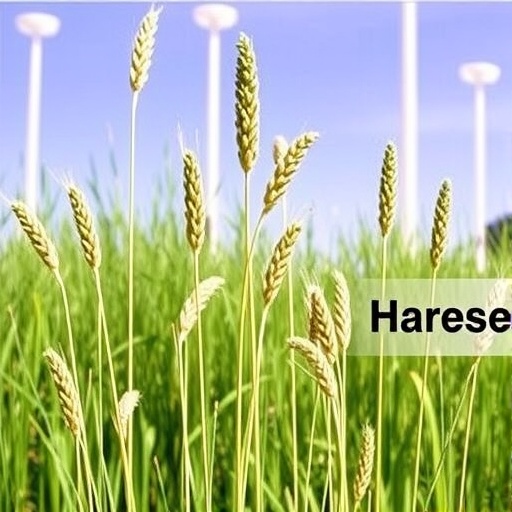In the world of plant genetics, the chloroplast genome plays a pivotal role in understanding evolutionary changes and adaptations among species. A groundbreaking study published in BMC Genomics has recently taken a deep dive into the chloroplast genomes of fifty-four samples drawn from five distinct species and two varieties of Agropyron Gaertn., a member of the Poaceae family, particularly the Triticeae tribe. This comprehensive research aims to illuminate the genetic underpinnings that contribute to the diversity and ecological adaptability of these grass species.
The study’s authors, Zheng, Duan, and Zhang, along with their colleagues, have meticulously extracted and sequenced the chloroplast DNA from these samples, leading to various discoveries regarding their genetic structure and evolutionary history. The chloroplast, often regarded as the green powerhouse of plant cells, not only facilitates photosynthesis but also harbors genes essential for growth and development. By examining chloroplast genomes, researchers are gaining insights into phylogenetic relationships as well as the mechanisms of speciation within these grass species.
One of the core objectives of the study was to uncover the variations in the chloroplast genomes across the different Agropyron species and varieties. The findings suggest compelling differences that are not superficially apparent but indicative of the unique evolutionary trajectories followed by each species. Such variations can provide critical information regarding adaptation to diverse environmental conditions, revealing how these plants have successfully colonized different habitats across the globe.
The research methodology employed in the study was meticulously designed to ensure comprehensive results. The authors began with the collection of samples from various geographical locations, aiming to represent a wide array of habitats where these species thrive. Following collection, the scientific team utilized advanced genomic technologies for sequencing, utilizing high-throughput methodologies that enable the analysis of massive amounts of genetic data in a relatively short timeframe.
Once sequencing was completed, bioinformatics tools were utilized to analyze the genomic data, comparing the sequences across species. The researchers concentrated on gene composition and structure, examining the functional elements within the chloroplast genomes to ascertain how they contribute to the organism’s fitness in its respective environment. This comparative analysis is crucial for understanding the genomic architecture that supports the survival and reproductive success of these plants.
Another critical aspect of the study focuses on the implications of chloroplast genome variations on biodiversity conservation efforts. Understanding the genetic diversity within Agropyron species aids in developing strategies that can help maintain ecological balance and preserve threatened habitats. With climate change and human activity posing ever-increasing threats to natural ecosystems, such genetic insights can inform conservation priorities and actions.
One particularly fascinating outcome of this research was the discovery of specific mutations that were repeatedly identified across several samples. These mutations were hypothesized to provide certain adaptive advantages, which could mean that the evolution of these chloroplast genomes is not entirely random. This notion opens up further questions regarding the pressures exerted by environment and competition on plant genomic evolution, leading to deeper investigations into how external factors influence genetic variation.
Moreover, the study underscores the significance of inter-species genetic comparisons. By juxtaposing the chloroplast genomes of related species, researchers can detect evolutionary patterns that shed light on the broader dynamics of plant evolution. Such information is not only vital for academic research but also informs agricultural practices, particularly for species that are economically significant.
In the broader context of genomics and evolutionary biology, this study exemplifies the collaborative nature of modern research. It integrates knowledge from diverse fields, such as ecology, molecular biology, and bioinformatics, thus demonstrating the importance of interdisciplinary approaches in tackling complex biological questions. Researchers involved in this study represent a growing community committed to revealing the myriad secrets of plant genomes, thereby contributing to a deeper understanding of biodiversity and its preservation.
Furthermore, the implications of this research extend beyond typological classifications. The understanding gleaned from chloroplast genome analysis allows for the prediction of how specific species may respond to future environmental changes. This predictive power is essential as it can guide proactive measures to ensure the sustainability of agri-ecosystems and protect species at risk of extinction.
As the scientific community moves towards embracing the genetic diversity that exists within plants, studies such as this will play an increasingly vital role. They create a foundation for future genomic research, paving the way for advancements in genetic engineering and biotechnology, particularly in the context of crop improvement and resilience against adversities.
In conclusion, the comparative analysis of chloroplast genomes in the Agropyron species presents an enlightening addition to our understanding of plant evolutionary dynamics. With chloroplast genomes offering a window into the evolutionary past, this research contributes significantly to our knowledge of biodiversity, adaptation, and environmental resilience. As scientists continue to unravel the complexities of plant genomes, the potential for practical applications in agriculture and conservation remains substantial, promising a future where science and nature coalesce for the betterment of both.
This remarkable study not only contributes tremendously to the field of plant genetics but also sets the stage for future explorations. The ongoing quest to understand the genetic fabric of our planet’s flora will undoubtedly yield insights that transcend academic curiosity, leading to innovative solutions for some of humanity’s most pressing environmental challenges.
Subject of Research: Comparative analysis of chloroplast genomes in Agropyron species
Article Title: Comparative analysis of Chloroplast genomes in 48 samples from 5 species and 2 varieties of Agropyron Gaertn. (Poaceae, Triticeae)
Article References:
Zheng, L., Duan, M., Zhang, Z. et al. Comparative analysis of Chloroplast genomes in 48 samples from 5 species and 2 varieties of Agropyron Gaertn. (Poaceae, Triticeae). BMC Genomics 26, 912 (2025). https://doi.org/10.1186/s12864-025-12026-6
Image Credits: AI Generated
DOI: 10.1186/s12864-025-12026-6
Keywords: Chloroplast genomes, Agropyron, genetic diversity, evolution, conservation, comparative genomics
Tags: Agropyron species geneticsBMC Genomics research findingschloroplast DNA sequencingchloroplast genome analysisecological adaptability of Agropyronevolutionary adaptations in grassesgenetic diversity in plant speciesphylogenetic relationships in grassesplant genetics and evolutionPoaceae family researchspeciation mechanisms in plantsTriticeae tribe studies





